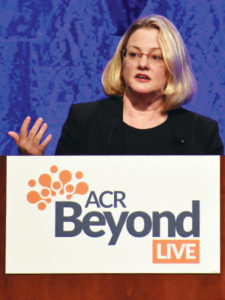
Up to 10 percent of all rheumatology patients have fibromyalgia, and there can be significant overlap with rheumatoid arthritis, osteoarthritis, lupus, and other common rheumatologic complaints, according to one of the presenters at the Pre-Meeting Course ACR Review Course on Saturday.
“Those of us who think they have not seen fibromyalgia just don’t recognize it,” said Kristine Phillips, MD, PhD, Associate Professor of Medicine, Vanderbilt University Medical Center. “You need to be able to identify fibromyalgia, educate your patients about it, and help them get the care they need. Missing fibromyalgia means missing an opportunity for optimal management, and very possibly inappropriate immunosuppression.”
Pain is the most common reason patients come to rheumatologists. And fibromyalgia is among the most complex pain entities rheumatologists see on a regular basis, said Dr. Phillips, who discussed the latest fibromyalgia findings as part of the popular all-day review course that covered many rheumatology topics.
“Fibromyalgia has not been adopted by any one specialty, so it is seen in a wide variety of settings: primary care, psychiatry, sports medicine, rheumatology,” she said. “And it has a complex etiology with a variety of different contributory and contextual factors.”
Fibromyalgia was not named until 1976. The first ACR fibromyalgia criteria, published in 1990, included 18 trigger points.
Later modifications use a widespread pain index and symptom severity index. The index includes chronic widespread pain, heightened response to pressure, comorbid fatigue, and mild cognitive difficulties, often referred to as “fibro fog.” Patients may also exhibit restless leg syndrome and paresthesias. Fibromyalgia is associated with affective disorders such as anxiety and depression, but not with other forms of mental illness such as schizophrenia.
Most patients fall into one of four clusters: fibromyalgia and comorbid pain-related depression, which may respond to anti-depressants; depression with concomitant fibromyalgia, which may also respond to anti-depressants; sensitivity to pain without psychiatric conditions, which may respond to 5-HT3 receptor blockers; and fibromyalgia due to somatization, which may respond to psychotherapy.
Patients may also have mixed-type fibromyalgia.
Fibromyalgia is a neurobiological disease, Dr. Phillips said. Brain regions associated with physical pain overlap with psychological pain processing. It involves changes in sensory discrimination as well as affective emotional factors.
The disease has both anatomic and psychiatric/psychosocial mechanisms. Central sensitization and central pain hypersensitivity result in increased sensitivity to pain or pressure and altered pressure/pain thresholds. Effective management begins with validation of the patient’s symptoms, education, improved sleep, exercise, and mental health awareness.
If patients do not exercise, a physical therapy referral can be helpful. So are tai chi, yoga, exercise videos, and mobile phone apps such as MyFitnessPal. Cognitive behavioral therapy can help many patients, but CBT is not readily available in all areas, particularly in rural settings, and not all insurers cover CBT.
Transcutaneous electrical nerve stimulation can also help. Late-breaking abstract L19, “Transcutaneous Electrical Nerve Stimulation (TENS) Reduces Pain and Fatigue and Improves Disease Impact in Women with Fibromyalgia: A Randomized Controlled Trial,” will be presented as part of Tuesday’s Late-Breaking Abstract Session starting at 4 pm in Room W375c.
Medications should be a last resort. Start low and titrate upwards very slowly, remembering that patients can have a very difficult time getting off these drugs.
“Avoid writing that first opioid prescription,” Dr. Phillips said.
